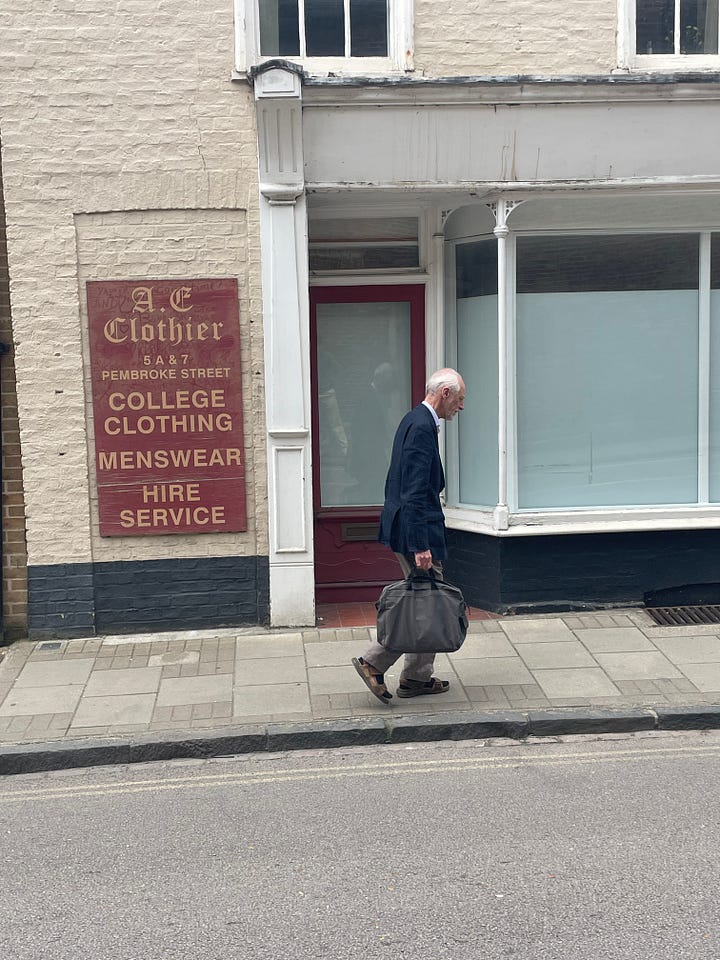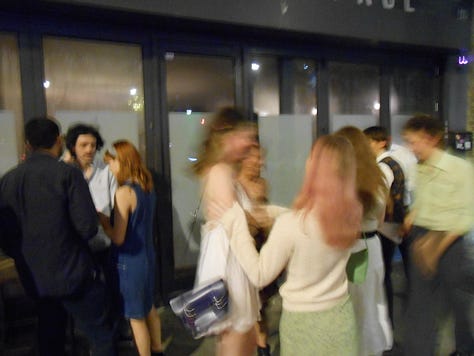

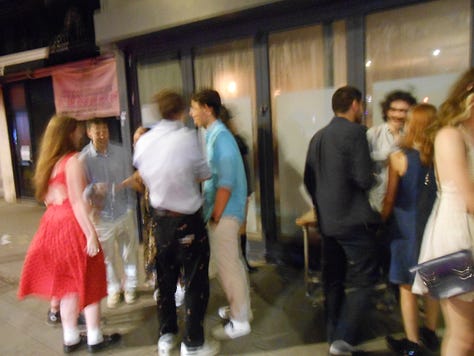
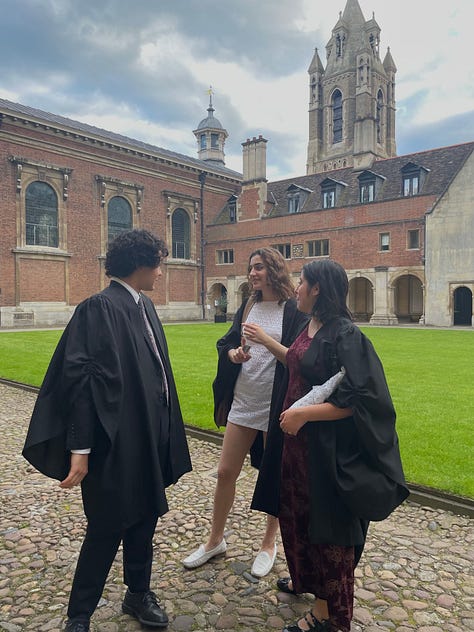
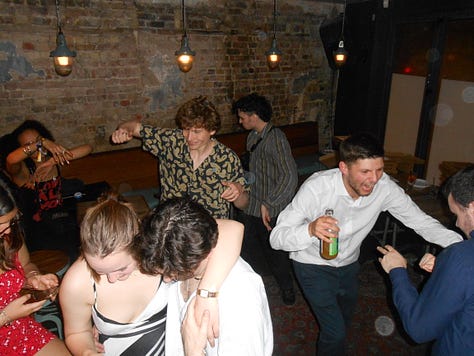
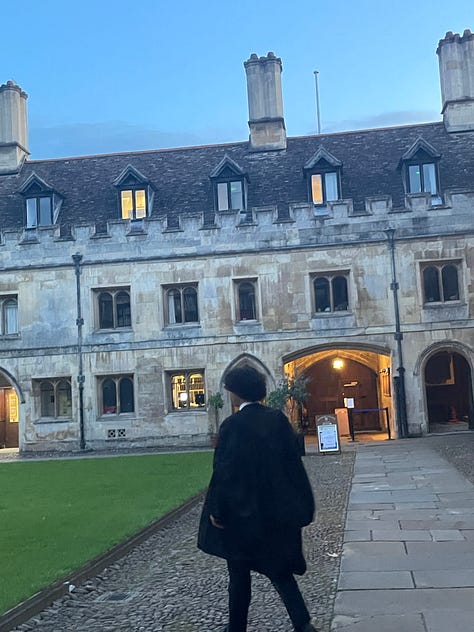
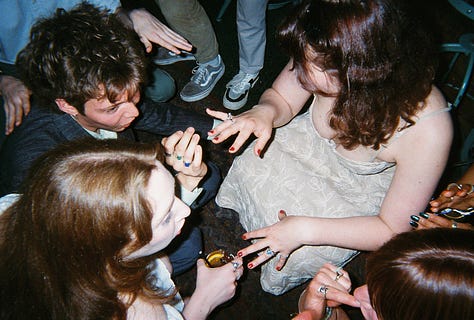
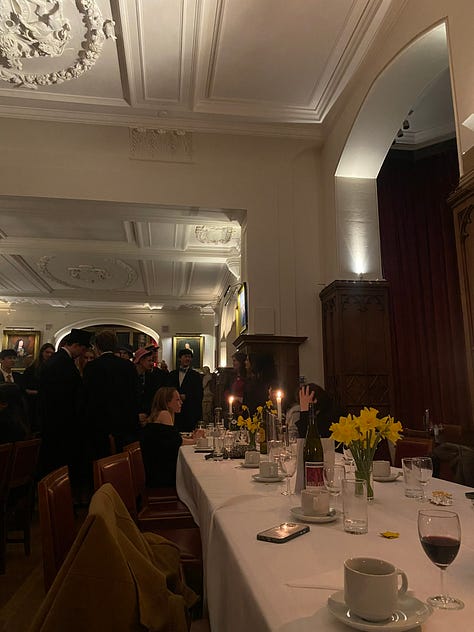
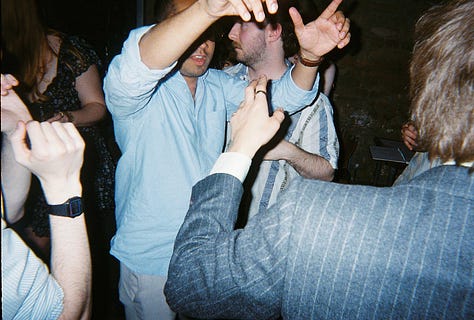
The Cambridge ‘gown’ is black, with massive sleeves. The thickness of the cloth and the way it is pleated makes the garment fall with a sense of monumentality, like the way cloth is rendered in Renaissance paintings. The ballooning shape broadens the shoulders and the chest, emphasising a monumental silhouette. The wearer looks positively Cantabrigian: self-serious, important, educated. But this oversized look simultaneously creates a certain level of comfort for the wearer. The sleeves are unencumbering, the robe fits over anything worn underneath. The pleating at the back, which sits closer to the bottoms of the shoulder blades than the neckline, brings the centre of gravity down and weighs the robe so that it suspends off the student’s neck casually. The entire structure of the garment relies on this casual hanging and nonchalant falling of fabric, though hours have been spent on meticulous pleats.
The robe is worn by a Cambridge student when, in Josh’s words, they are “performing the role as a student,” at matriculation, graduation, at formal dinners, and supposedly when exams are taken in person. Students used to be expected to wear the robe every day after dusk. But wearing a robe to formal is more than just wearing it to the performance, while sitting down at the table, it is all the little moments up to and after the performance. It might mean running late to formal with the robe trailing behind; it might mean talking animatedly with friends holding a bottle of wine in the crux of a robed arm in the quad before the meal; it might mean pre-drinking in your student kitchen while pulling it on; it might mean going to the pub afterwards, still performing the role as a student; it might mean jumping in the river or lying on grass past dusk and getting it wet or dirty; it might mean standing outside your friend’s flat rolling a cigarette shrouded, still, in dark, majestic pomp. Olivia, a friend of mine who just graduated from Oxford, posted some Super 8 footage of her graduation where girls in similar robes frolic, swim, and throw paint at each other. The visuals of the costume being undone, being messy, being lived in, is perhaps a distillation of something that British people seem to really love about formality and events. What British people love just as much as any particular event are the pres and the afters—the bracketing moments.
A traditional British night out works on the tripartite system: pres, event, afters. It is a system that works well. This is no different from Katie’s 21st on Saturday, with more emphasis on the afters. Josh and I are sleeping on the sofa in her Hackney kitchen, so we are prepped in advance about the intention for an afters and the ways it might affect our sleeping schedule. After the venue kicks us out there is a text blast and some stunted conversation (told the DJ his set was a “bundle of fun”) and an Uber ride and an afters.
Pres and afters have intimacy, taking place in a domestic space (usually a kitchen or a bedroom), with a small group sitting on the floor in a circle, music quiet enough to hear each other over, some kind of game, someone asleep in the corner, a couple making off together or just flirting, two women telling each other how much they love each other, winding up and winding down, vodka and tequila. Hi I’m sorry I didn’t get your name but I absolutely love your necklace. You drew a three so you have to drink. Yeah so obviously I don’t want to be a bitch but I just didn’t like the way she went about that, yeah. Yeah. Mate!
Sunday is the day when, in exchange for singing at the beginning of the meal, the Pembroke choir comes to formal hall and eats for free. There’s about 30 of them, in their robes. They come in all at once, almost late, chaotically, holding half-drunken wine bottles and rosy cheeks, occupying one long table which is about half of the real estate in the room. They are giggling, including a little after the gong goes off and we have to all stand and wait in silence while the master of the college and college fellows file in to the high table and then a little more as the choir runs into position to sing their opening hymn.
As the sun approaches dusk through the tall Pembroke windows, all of us stand again as the master addresses his students and begins the file out. The fellows shuffle through a door to the left. It gives me a very 19th-century feeling, the men retiring into the smoking room after dinner, or perhaps the simpler feeling of being left at the kids’ table by the adults. There is a growing excitement on the choir table, they are all looking each other (and I’m looking at them).
As soon as the fellows leave and it is just the kids at the kids’ table, the choir breaks out into song: happy birthday! But happy birthday sung by people who usually sing hymns, so with very decadent descants. The birthday person gives a little speech, “I love you all so much, I wouldn’t rather be anywhere else on my birthday,” which is awkward but sweet because it’s only addressed to half the people in the room. Then the shoe thing, where at Pembroke you’re supposed to drink from a shoe on your birthday. They sing “I’ve never seen [name] do a shoe” to the tune of She'll Be Coming Round the Mountain (note: no other beautiful nation could come up with the formulation ‘doing a shoe’ to represent this act). But the birthday person is wearing sandals and I guess there’s no protocol for this kind of situation so they sit back down. But alas, another birthday on the non-choir table so the whole dance is repeated and I see a real human person drink wine from their real shoe.
Robe on, shoe off, still at the candlelit dinner table, wine drunk, playing with formality and tradition. This kind of activity is so fascinating, the doing-silly-things-after-formal, because it is simultaneously so traditional and established (we are in a college that was founded in 1347) but so of the moment and of the people in the room right now (even though the silly things in this moment that feel so unique are in concert with a whole host of similar silly things that have been happening in this college for these past 8 centuries). This is what tradition, pomp, circumstance, repetition, and their associated costumes all offer: a bowtie that has been loosened, a top button undone, a shoe with wine in it, the casual singing of a descant—the afters. The afters which elicit the same excitement for the British people (if I am to generalise) as the more humble undoings and winding downs that happen at afters after Hackney birthday parties.
